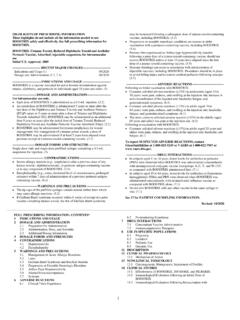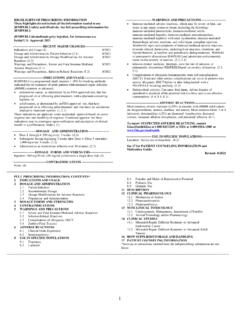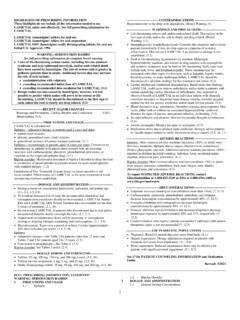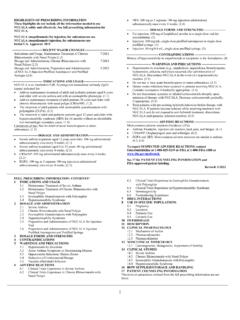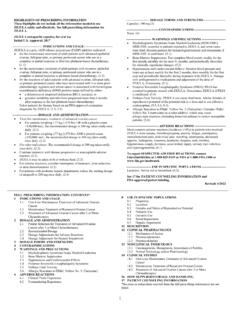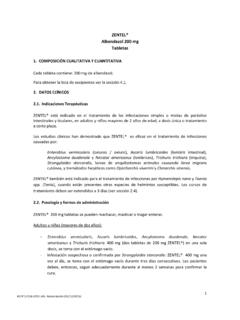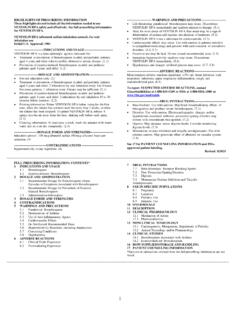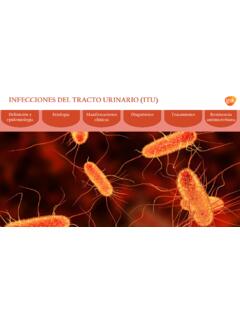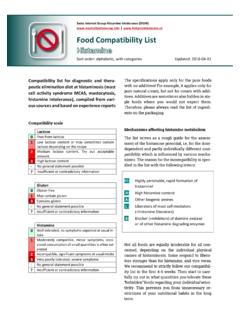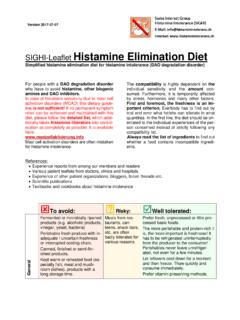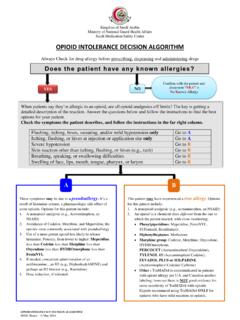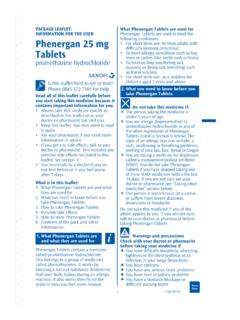Transcription of ZYRTEC ORAL DROPS 10 mg/ml ZYRTEC ORAL SOLUTION 1 …
1 Page 1 of 18 PDS-02 ZYRTEC SCHEDULING STATUS: S2 PROPRIETARY NAME AND DOSAGE FORM: ZYRTEC tablets ZYRTEC oral DROPS 10 mg/ml ZYRTEC oral SOLUTION 1 mg/ml COMPOSITION: Each film-coated tablet contains 10 mg cetirizine dihydrochloride. Excipients: Tablet core: microcrystalline cellulose, colloidal anhydrous silica, lactose monohydrate and magnesium stearate. Tablet coating: Opadry Y-1-7 000 (hypromellose, titanium dioxide and polyethylene glycol. Each 1 ml oral DROPS contains 10 mg cetirizine dihydrochloride. Excipients: glycerol, propylene glycol, saccharin sodium, sodium acetate, glacial acetic acid, purified water and methyl parahydroxybenzoate 0,135 % m/v and propyl parahydroxybenzoate 0,015 % m/v as preservatives.)
2 Each 1 ml oral SOLUTION contains 1 mg cetirizine dihydrochloride. Excipients: sorbitol SOLUTION 70 %, glycerol, propylene glycol, saccharin sodium, sodium acetate, glacial acetic acid, purified water, banana flavour and methyl parahydroxybenzoate 0,135 % m/v and propyl parahydroxybenzoate 0,015 % m/v as preservatives. The oral DROPS and oral SOLUTION do not contain sucrose or alcohol. PHARMACOLOGICAL CLASSIFICATION: A Antihistaminics PHARMACOLOGICAL ACTION: Cetirizine dihydrochloride, a metabolite of hydroxyzine, is an anti-allergic agent, with a histamine H1 receptor antagonism devoid of any significant anticholinergic and antiserotonin effects as demonstrated in experimental and clinical pharmacology.
3 At the present stage of research into the mode of action of cetirizine, the anti-allergic activity seems to be exerted mainly via its effects on the release of certain mediators, such as histamine , together with a selective action on the H1 receptors. Cetirizine reduces eosinophil recruitment induced by an antigen-antibody reaction. Pharmacokinetic properties: Peak blood levels of 300 ng/ml are reached within one hour after oral administration of cetirizine. Cetirizine does not undergo extensive first pass metabolism. The terminal half-life is approximately 10 hours in adults, 6 hours in children aged 6 to 12 years and 5 hours in children aged 2 to 6 years.
4 These data are consistent with the urinary excretion half-life of the medicine. The cumulative urinary excretion represents about two thirds of the dose given in both adults and children. The apparent plasma clearance in children is higher than that measured in adults. Plasma levels are linearly related to the dosage given. A high proportion of cetirizine is bound to human plasma proteins. In patients with impaired renal clearance (less than 40 ml/min) and hepatic insufficiency, an increase in half-life and decrease in total clearance occurs. INDICATIONS: Allergic processes responding to a histamine H1 receptor antagonist. Respiratory: Allergic rhinitis, hay fever.
5 Cutaneous: Allergic skin conditions associated with pruritus urticaria. CONTRA-INDICATIONS: Page 2 of 18 PDS-02 History of hypersensitivity to any of the constituents of the formulations, to hydroxyzine or to any piperazine derivatives. Patient with severe renal impairment at less than 30 ml/min creatinine clearance. Patients with rare hereditary problems of galactose intolerance, the Lapp lactase deficiency or glucose- galactose malabsorption should not take ZYRTEC tablets. Patients with rare hereditary problems of fructose intolerance should not take ZYRTEC oral SOLUTION 1 mg/ml . ZYRTEC is contra-indicated in lactating women since the active ingredient is excreted in breast milk.
6 ZYRTEC is contra-indicated in pregnancy as the safety has not been established. In children under 2 years of age. The use of ZYRTEC tablets is not recommended in children less than 6 years since this formulation does not allow for appropriate dose adaptation. It is recommended to use a paediatric formulation of ZYRTEC . WARNINGS: Avoid alcohol consumption. Caution in epileptic patients and patients at risk of convulsions is recommended. INTERACTIONS: To date there are no known interactions between cetirizine with other medicines. Studies with diazepam, glipizide, pseudoephedrine, antipyrine, ketoconazole, azithromycin, erythromycin and cimetidine have revealed no evidence of pharmacokinetic interactions.
7 Allergy skin tests are inhibited by antihistamines such as ZYRTEC and a wash-out period of 3 days is recommended before performing them. PREGNANCY AND LACTATION: ZYRTEC is contra-indicated in pregnancy and lactation (refer to CONTRA-INDICATIONS). DOSAGE AND DIRECTIONS FOR USE: Tablets: Adults or children 12 years of age or older: one 10 mg tablet daily. Children 6 to 12 years old: 10 mg (one tablet) once daily or 5 mg (half a tablet) twice daily. oral DROPS : Adults or children 12 years of age or older: 10 mg (20 DROPS ) once daily. Children 6 to 12 years old: 10 mg (20 DROPS ) daily, either as a single dose or as divided doses of 10 DROPS in the morning and 10 DROPS in the evening.
8 Children 2 to 6 years old: 5 mg (10 DROPS ) daily, either as a single dose or as divided doses of 5 DROPS in the morning and 5 DROPS in the evening. oral SOLUTION : Adults or children 12 years of age or older: 10 mg (10 ml) once daily. Children 6 to 12 years old: 10 mg (10 ml) daily, either as a single dose or as divided doses of 5 ml in the morning and 5 ml in the evening. Children 2 to 6 years old: 5 mg (5 ml) daily, either as a single dose or as divided doses of 2,5 ml in the morning and 2,5 ml in the evening. At present there are no data to suggest that the dose needs to be reduced in elderly patients with normal renal function. In patients with renal insufficiency (creatinine clearance less than 40 ml/min), the dosage should be reduced to half the usual recommended dose.
9 Half the recommended daily dose should be used in patients with moderate to severe hepatic impairment. SIDE EFFECTS AND SPECIAL PRECAUTIONS: Side effects: ZYRTEC has potential adverse effects on the CNS, including somnolence, fatigue, dizziness and headache. In some cases, paradoxical CNS stimulation has been reported. Page 3 of 18 PDS-02 ZYRTEC is a selective antagonist of peripheral H1-receptors and is relatively free of anticholinergic activity. Nevertheless, cases of micturition difficulty, eye accommodation disorders and dry mouth have been reported. Instances of abnormal hepatic function with elevated hepatic enzymes accompanied by elevated bilirubin have been reported.
10 Clinical trial data: Double blind controlled clinical trials at the recommended dosage (10 mg daily for ZYRTEC ), of which quantified safety data are available, included more than 3 200 subjects exposed to ZYRTEC . Frequencies are defined as follows: Very common ( 1/10); common ( 1/100 to < 1/10); uncommon ( 1/1 000 to < 1/100); rare ( 1/10 000 to < 1/1 000); very rare (< 1/10 000), not known (cannot be estimated from the available data). The following adverse reactions were reported: Psychiatric disorders: Common: somnolence Nervous system disorders: Common: dizziness, headache Respiratory, thoracic and mediastinal disorders: Common: pharyngitis Gastrointestinal disorders: Common: dry mouth, nausea Uncommon: abdominal pain General disorders and administration site conditions: Common: fatigue.
